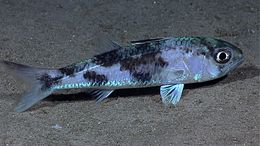Acropomatidae
| Acropomatidae Temporal range:
| |
|---|---|

| |
| Synagrops bellus | |
| Scientific classification | |
| Domain: | Eukaryota |
| Kingdom: | Animalia |
| Phylum: | Chordata |
| Class: | Actinopterygii |
| Order: | Perciformes |
| Superfamily: | Percoidea |
| Family: | Acropomatidae T. N. Gill, 1893 |
| Genera [2] | |
|
Acropoma Temminck & Schlegel, 1843 | |
Acropomatidae is a family of fish in the order Perciformes, commonly known as lanternbellies. Acropoma species are notable for having light-emitting organs along their undersides. They are found in all temperate and tropical oceans, usually at depths of several hundred meters.[3]
Members of the family are generally small, with some ranging up to 40 cm, but most no more than 15 cm. They have two dorsal fins, the first with seven to 10 spines and the second with possibly a spine in addition to eight to 10 soft rays. The anal fin has two or three spines, and the pelvic fins one spine and five soft rays.
Timeline of genera

References
- ^ Sepkoski, J.J.Jr (2002): A Compendium of Fossil Marine Animal Genera. Archived 2011-07-23 at the Wayback Machine Bulletins of American Paleontology, 363: 1-560.
- ^ Yamanoue, Y. (2016): Revision of the genus Verilus (Perciformes: Acropomatidae) with a description of a new species. Journal of Fish Biology, 89 (5): 2375–2398.
- ^ Froese, Rainer, and Daniel Pauly, eds. (2016). "Acropomatidae" in FishBase. June 2016 version.
